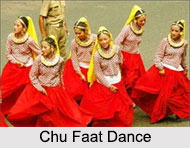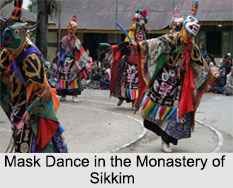 Sikkim is a land of different tribes and races of people together. These diverse tribes and communities have exclusive features in adding to their characteristic dance forms, culture and technique forms. The Folk dances of Sikkim are traditional and extremely exciting. Most of the Folk Dances relate to the beauty of the natural surroundings, some describe the harvest season while others are performed for good luck and prosperity.
Sikkim is a land of different tribes and races of people together. These diverse tribes and communities have exclusive features in adding to their characteristic dance forms, culture and technique forms. The Folk dances of Sikkim are traditional and extremely exciting. Most of the Folk Dances relate to the beauty of the natural surroundings, some describe the harvest season while others are performed for good luck and prosperity.
Different Folk Dances of Sikkim
The folk dances of Sikkim celebrate the harvest and the wealth period in Sikkim. These folk dances are accompanied by singing, traditional musical instruments and the traditional masks with bright costumes. Following are the Different Folk Dances of Sikkim:
Lu Khangthamo: This form of dance is enjoyed by every age group in their traditional dresses and ornaments. On the events like house-warming and New Year celebrations, this dance is presented in the company of pleasing songs and music. "Lu Khangthamo" is a "Bhutia" folk dance that is famous to thank all the Gods and deities of the three worlds.
Maruni: This beautiful dance is presented on marriages. "Maruni" dancers wear multi-coloured costumes and heavy ornaments. "Maruni" dancers are usually focused by a clown known as `Dhatu Waray`. "Maruni" is one of the most well-liked and the oldest dance of the Nepalese.
Rechungma: It is generally organized on events like childbirth, marriage and other social assemblies. "Rechungma" is a kind of Sikkimese dance that is presented to illustrate gratitude towards God for his continued consents.
Limboo: The dance includes composite footwork that is tuned with the hits of "Chyap-Brung". This dance has only rhythmic music.
Mask Dance: Mask Dance is the famous dance of Sikkim. The Mask dance is divided into different types, "Enchey Chaam", "Rumtek Chaam` and "Gouthor Chaam".
Yak Chaam and Singhi Chaam: Both of these dances are the Tibetan forms of dance. Yak Chaam is a tribute to an animal "Yak" and Singhi Chaam is an essential dance form, which is connected to the five peaks of Mount "kanchenjunga" shaping an image of snow lion.
Tamang Selo: The dance is presented with the melodious tunes of `Damphoo` which is a musical instrument that the dancers take in their hands. "Tamang Selo" is a Nepali form of dance that portrays the `Tamangs` community of the "Nepalese".
 Chu Faat: "Chu faat" is considered as the oldest folk dance of Sikkim that belongs to the "Lepcha" group. The presentation of the dance is held according to the Tibetan calendar, which is 15th day of seventh month. The dancers dance on a lot of devotional songs and also carry green bamboo leaves and improved lamps in their hands throughout their performance.
Chu Faat: "Chu faat" is considered as the oldest folk dance of Sikkim that belongs to the "Lepcha" group. The presentation of the dance is held according to the Tibetan calendar, which is 15th day of seventh month. The dancers dance on a lot of devotional songs and also carry green bamboo leaves and improved lamps in their hands throughout their performance.
Gha to Kito: This "Bhutia" folk dance form is accompanied by songs which explain the state of Sikkim and its beauty.
Chi Rimu: This is a well-liked dance form presented in the entire happiest event in the family. This "Bhutia" folk dance is performed for praising the state of Sikkim.
Be Yu Mista: This is a well-liked "Bhutia" folk dance performed in Sikkim admiring its natural magnificence.
Kagyed: This dance represents the ruin of evil over good and the look forward to peace and affluence in Sikkim. The dancers are well-liked "Chaam" and the dance is accompanied by music and singing. This dance form is performed by the monks in the 28th and 29th day of the 10th month of the Tibetan calendar.
 Khukuri: This dance form is a heroism warrior dance form which is performed in an honour of the ritual of giving religious touch to soldiers sent for battle.
Khukuri: This dance form is a heroism warrior dance form which is performed in an honour of the ritual of giving religious touch to soldiers sent for battle.
Sikmari: The "Sikmari" dance is mainly a youth dance where all the youth of the state assemble to present the dances that reveal the beauty of nature and the power of love.
Chutkay dance: It is a romantic group dance performed by a group of male and female dancers. Chutkay dance portrays joys of life and feeling of happiness during the harvesting season. It is also performed during festivals and celebrations.
Zo-Mal-Lok dance: This is a popular folk dance of the Lepcha community reflecting normal activities such as sowing, reaping and harvesting of paddy. The graceful movements of male and female dancers become more mesmerizing. Musical instruments like Tungbuk, Flute, Cymbal, Drum, etc. are used to support this folk dance.
Denzong Gnenha dance: It is a religious folk dance performance depicting the profound faith of the Bhutia community in their indigenous Gods. Dancers celebrate the sweetness of nature wearing unique headgear made by the Sikkimese women.
Tashi Yangku dance: This folk dance is believed to bring good destiny to the land. Bhutia community performs Tashi Yangku dance to please Gods and Goddesses who control the natural phenomenon like floods, landslides, droughts, snowfalls, etc. and bring prosperity.
Denong-Neh-Nah: This is a folk dance form of the Bhutia tribe. It is a group dance form performed by both boys and girls to pay homage and seek blessings from past saints like Guru Rimpoche and also present saints. Flute, Yangjey, Drum, and Yarka are used a musical instruments to create the background music for this dance.
Naumati: This is a beautiful group dance of Damai community, a section of the Nepali tribes. Nine different musical instruments are used to play the background music of this performance. The instruments include two types of Senai, small and big Turhi, two types of Damaha, two types of Tuyamko, Dholki and Jhyamta. This dance form is mostly performed on wedding and other auspicious occasions.
Tendong Lho Rum Faat: It is a folk dance of the Lepha community of Sikkim. The dance narrates a famous Lepha folklore that has been passed down from generations in the form of lyrical poetry. According to the legend, this group dance is performed to save people from the onslaught of mighty mountainous rivers.



















